Towering over Athens at a height of 490 feet, the Acropolis of Athens (Ακρόπολη Αθηνών) was the cultural and religious centre of ancient Athens for thousands of years. This sprawling complex, composed of multiple significant cultural-religious structures, is Greece’s most famous landmark and the foremost symbol of the ancient Greek world.
The Acropolis has seen continued use and habitation since as early as the 4th millennium BC with successive developments being built upon the ruins of the previous complex. Most of what we see today is the result of a building effort began in around 449 BC by Athenian statesman Pericles, intended to move the site beyond its prior destruction during the 480 BC Persian invasion of Athens. The result is a stellar remnant of ancient Greek art and architecture, while the site’s own history contributed to making the Acropolis a rich multi-layered archaeological site.
Entering the Acropolis
The word “Acropolis” comes from the Greek word Ἀκρόπολις, which can be translated as “highest city” (from άκρος and πόλις), meaning “Acropolis” technically refers only to the peak. However, the Acropolis today is more than just the collection of structures at its peak, as it slopes also once hosted a variety of cultural-religious structures. These ruins can still be seen today on the South Slopes, and will be covered in a separate post to keep this post from getting too long.
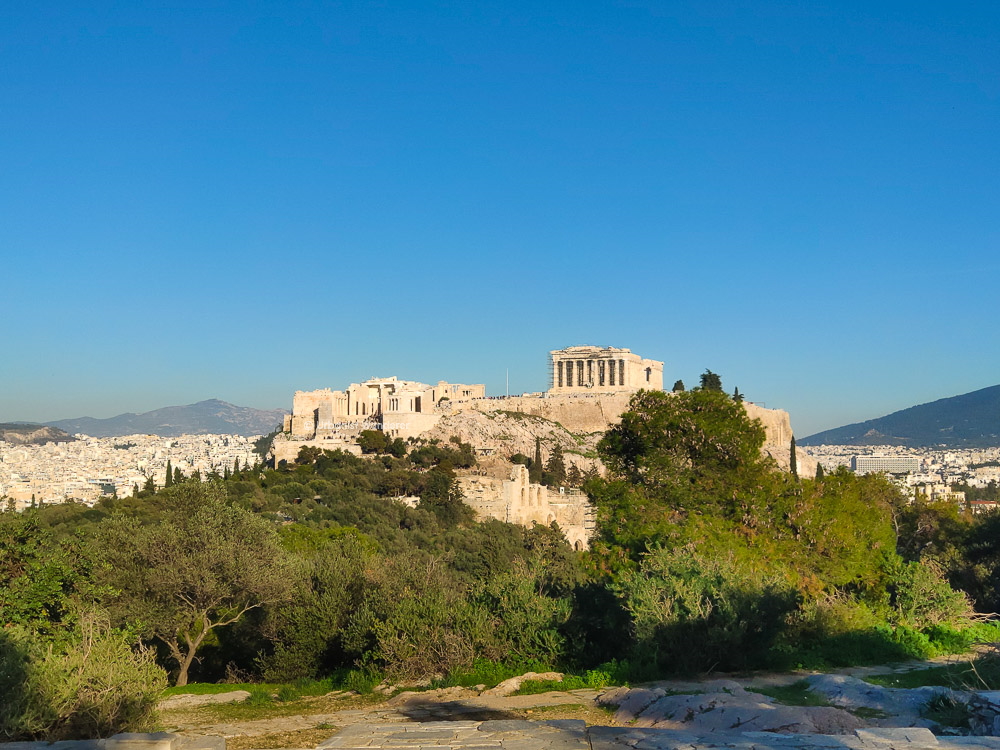
There are two ways to access the Acropolis – a a gate at the South Slopes that leads you slowly up the pathway to the top, and there is also a gate on the western slope that brings you straight up to the top via the Beulé Gate. If you are a first timer, I recommend the walk up the South Slopes to better appreciate the significance of the entire site, but also because the slow walk is more dramatic and builds the anticipation as you slowly approach the peak.
The Propylaia | Προπύλαια
The paths from the Beulé Gate and the South Slopes converge at the base of the steps leading up to the monumental Propylaia, the gateway to the Acropolis.
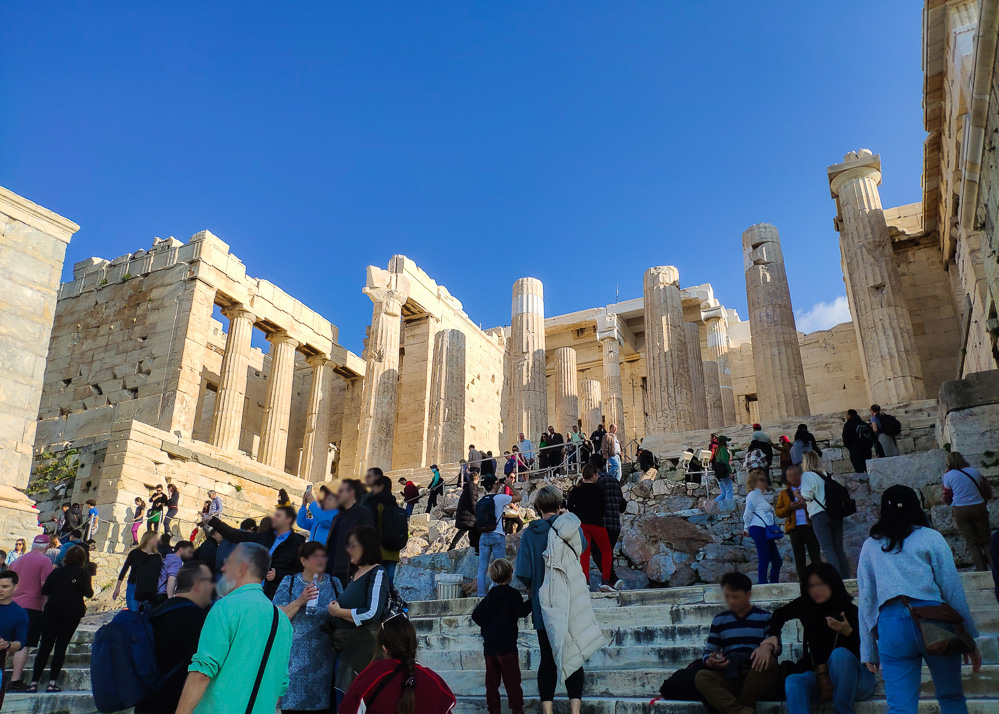
Construction of the Propylaia began in 437 BC and was left unfinished in 432 BC due to the Pelopennesian War. The design called for a central portico flanked by two large halls with the processional pathway into the Acropolis proper being routed through the portico. This forms the visitor path today, and the walk through the Propylaia gives visitors the chance to experience entering the Acropolis under a monumental gateway. It’s quite memorable, honestly.
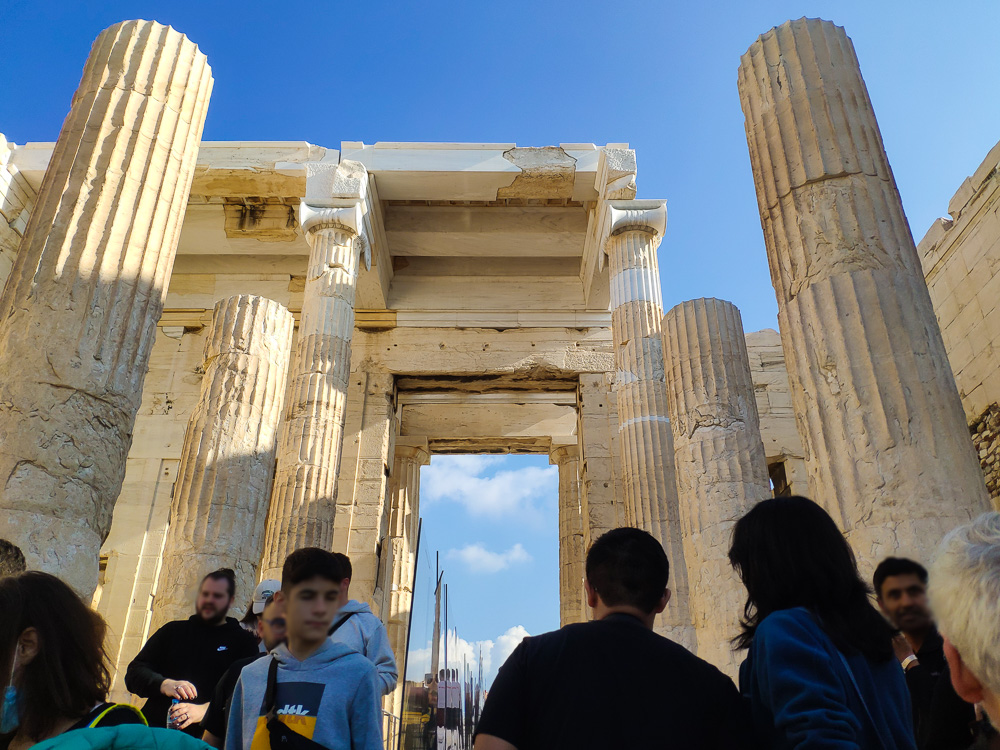
Look closely at the marble surfaces and you’ll notice a good number of pieces and blocks that are brand new – these are restorations as part of the Acropolis Restoration Project, a massive project intended to repair damage to the site and further conserve these architectural wonders. Per the Acropolis Restoration Service, the works involve:
“… dismantling of the areas where structural problems had been identified, removal of inappropriate materials (concrete and iron) that had been used during pre-war interventions, structural restoration of fragmented architectural members in laboratories, fillings with the use of new marble in areas where there was an imperative need, repositioning of the restored ancient and new architectural members and restoring the monuments structure conforming to their authentic construction system.”
– The Acropolis Restoration Service
Take the time to look up at the ceiling of the portico, and you’ll be rewarded with a view of the six-metre long marble beams supporting the ceiling of the portico. You can also see the coffers built into the ceiling, which apparently used to be decorated with either golden stars on a blue field, or an arrangement of palmettes.

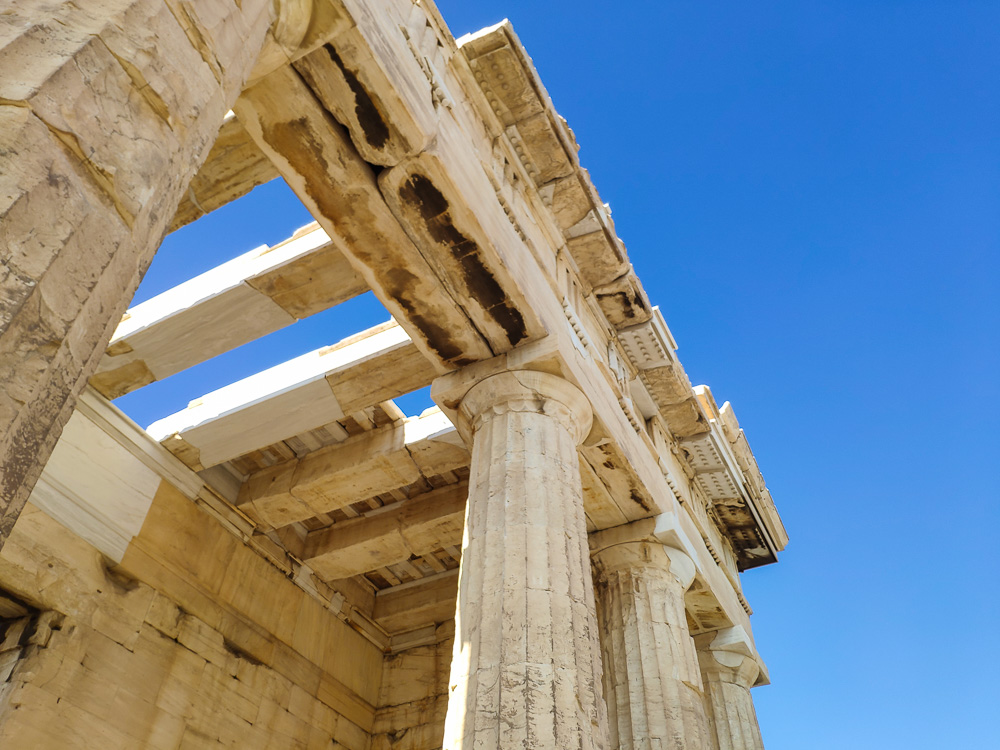
The walkway under the Propylaia then connects to a concrete pathway stretching throughout the peak. This was controversial, but on the bright side it does provide a flat surface for easier access around the site. Even though I visited during Winter (usually considered non-peak), the popularity of the Acropolis meant that the site was still quite full of visitors.
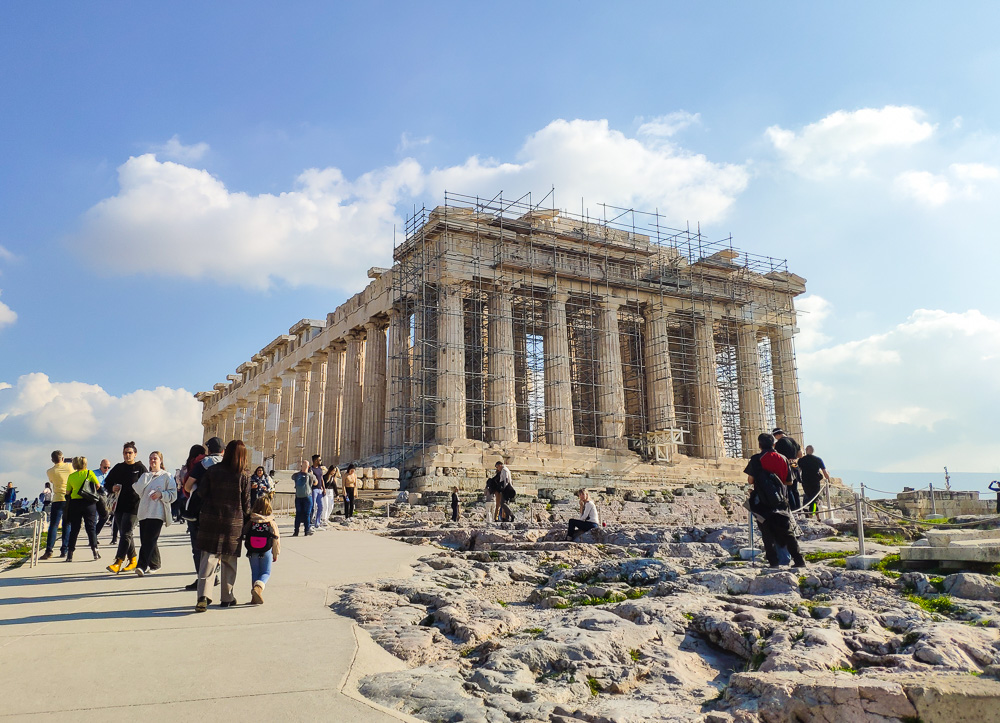
Temple of Athena Nike | Ναός Αθηνάς Νίκης
Not everything is monumental though. Turn around while heading through the Propylaia and you’ll lay eyes on the Temple of Athena Nike. Built around 420 BC, This diminutive temple to the Greek goddess of Victory, the form of whom is combined with the goddess Athena, is situated in the southwest corner of the Acropolis and to the right of the Propylaia and contrasts heavily with its much bigger neighbours. While it looks generally intact, the structure as it stands today hails from an 1834 reconstruction after it was destroyed during the Ottoman era.
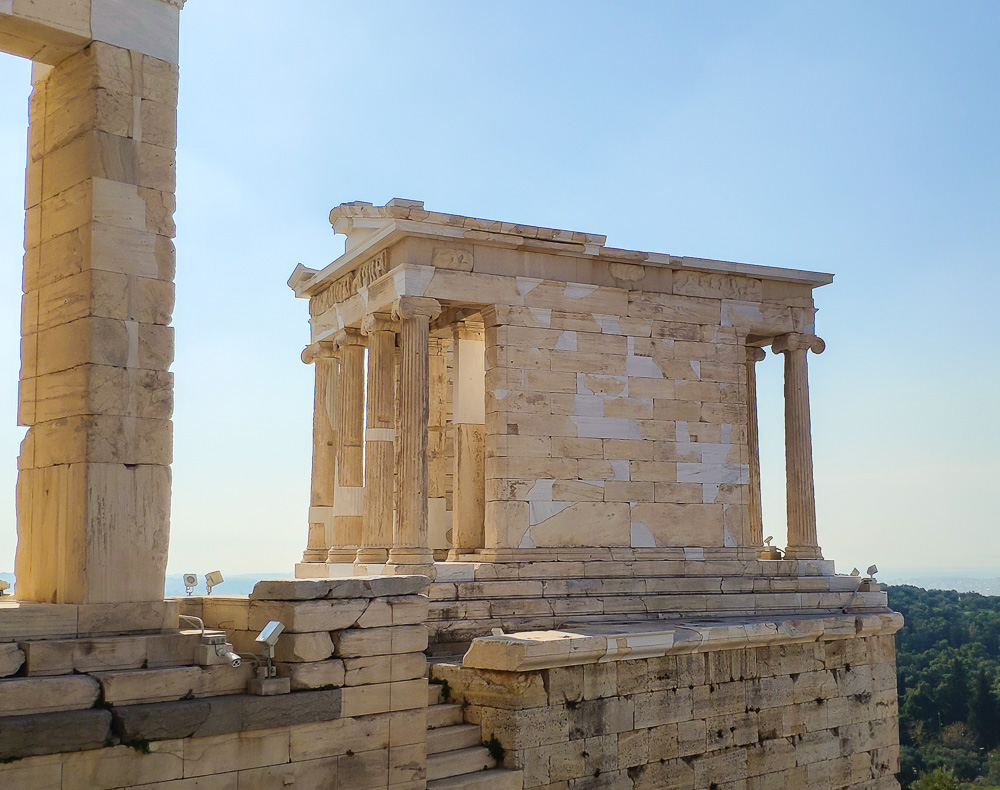
The Temple is not generally accessible to the public, so the closest you can get to it is on the Propylaia pathway. If you want to get up close with its decorative feature, you’ll have to make your way to the nearby Acropolis Museum – much like its counterparts, some of the Temple’s decorative features have been replaced by replicas to halt further deterioration to the original.
The Athena Promachos | Ἀθηνᾶ Πρόμαχος
The ruins of a marble pediment can be seen just a few steps in front of the Propylaia. This was the base of a colossal bronze statue known as the Athena Promachos (Ἀθηνᾶ Πρόμαχος), a representation of the goddess Athena in her guise as the goddess of wisdom and warriors. The term “Promachos” refers to ancient Greek/Byzantine soldiers in the first line of the phalanx, so Athena Promachos is essentially a representation of Athena as a front line warrior complete with a spear and a shield.
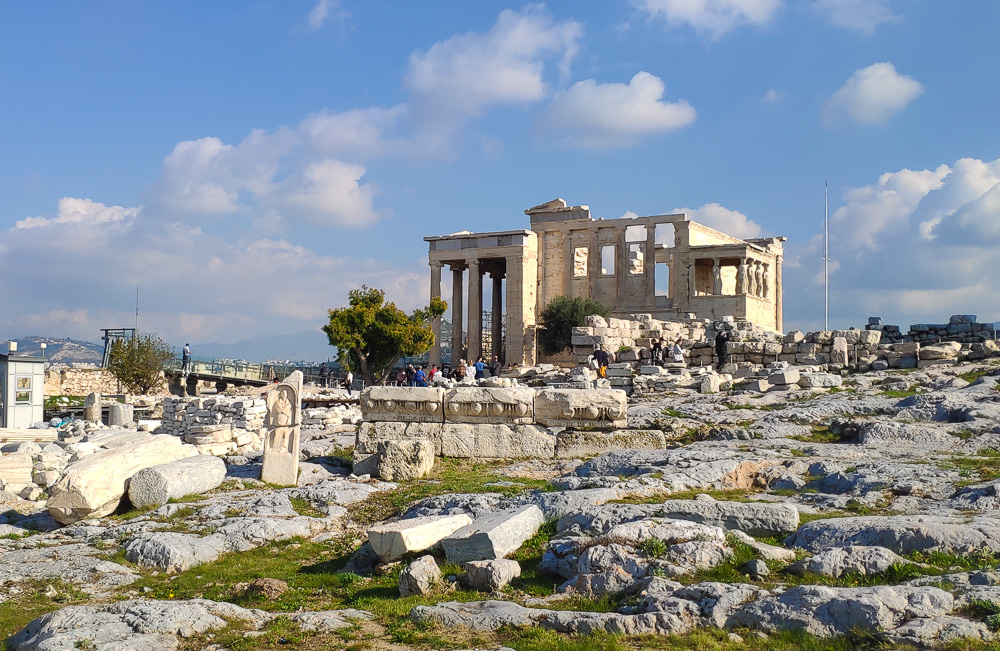
Believed to have been first erected around 456 BC, the statue became well known in antiquity for its size and prominence. The Greek-Byzantian historian Niketias Choniates (Νικήτας Χωνιάτης) puts the height of the statue at 30 feet (9.1 metres) tall, and I can really do no better than to reproduce Pausanias’s description of the Athena Promachos:
[2] In addition to the works I have mentioned, there are two tithes dedicated by the Athenians after wars. There is first a bronze Athena, tithe from the Persians who landed at Marathon. It is the work of Pheidias, but the reliefs upon the shield, including the fight between Centaurs and Lapithae, are said to be from the chisel of Mys, for whom they say Parrhasius the son of Evenor, designed this and the rest of his works. The point of the spear of this Athena and the crest of her helmet are visible to those sailing to Athens, as soon as Sunium is passed. Then there is a bronze chariot, tithe from the Boeotians and the Chalcidians in Euboea. There are two other offerings, a statue of Pericles, the son of Xanthippus, and the best worth seeing of the works of Pheidias, the statue of Athena called Lemnian after those who dedicated it.
– Pausanias, Description of Greece, 1.28.2
The goddess stood watch over the city named after her for over 1000 years, until around 465 AD when the statue was moved from Athens to Constantinopole (now Istanbul). The same Niketias Choniates then records a riot in 1203 AD where a large statue of Athena was destroyed, now believed to have been the Athena Promachos.
The Erechteion (Ερέχθειο) and the Caryatid Porch (Η πρόστασις των Κορών)
On the mid-point of the northern side of the Acropolis stands the Ionic style Erechteion. This structure is thought to have been a joint sanctuary for Athena and Erechteus (Ἐρεχθεύς) (a mythical King of Athens), although there is presently no scholarly consensus on whether this was actually the case.
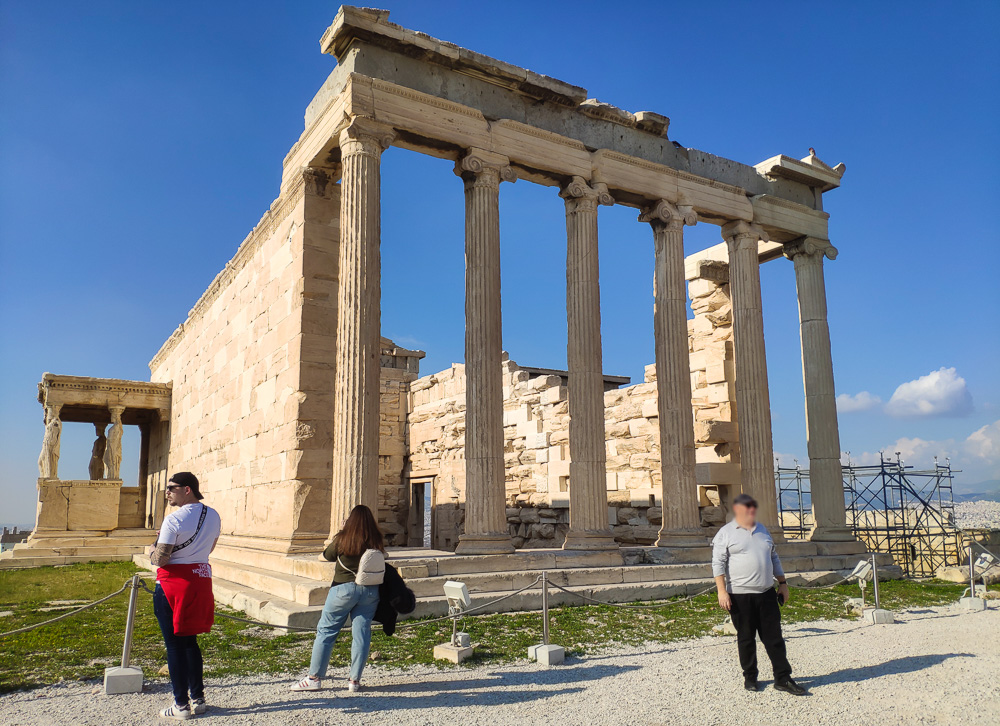
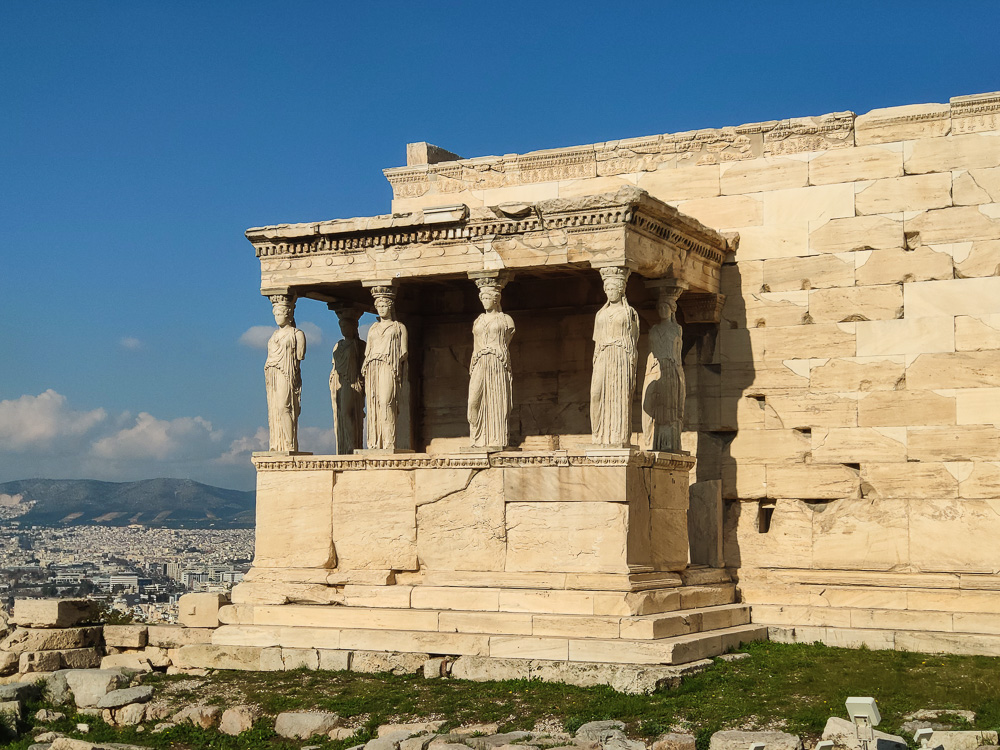
The Erechteion is best known for its southern porch, which has come to be known as the Caryatid Porch. The name is in reference to the six support pillars that were sculpted in the form of a female figure (the “Caryatid”). The Caryatids seen on site today are replicas as the originals were removed to be placed in the Acropolis Museum. One of them, however, was removed and taken to London by a certain Lord Elgin.
The Parthenon | Παρθενώνας
The crown jewel of the Acropolis is the imposing Parthenon – the ancient city’s premier temple to the goddess Athena. Standing 45 feet tall, the Parthenon is an enduring symbol of ancient Greece and considered a high point of classical Greek art.
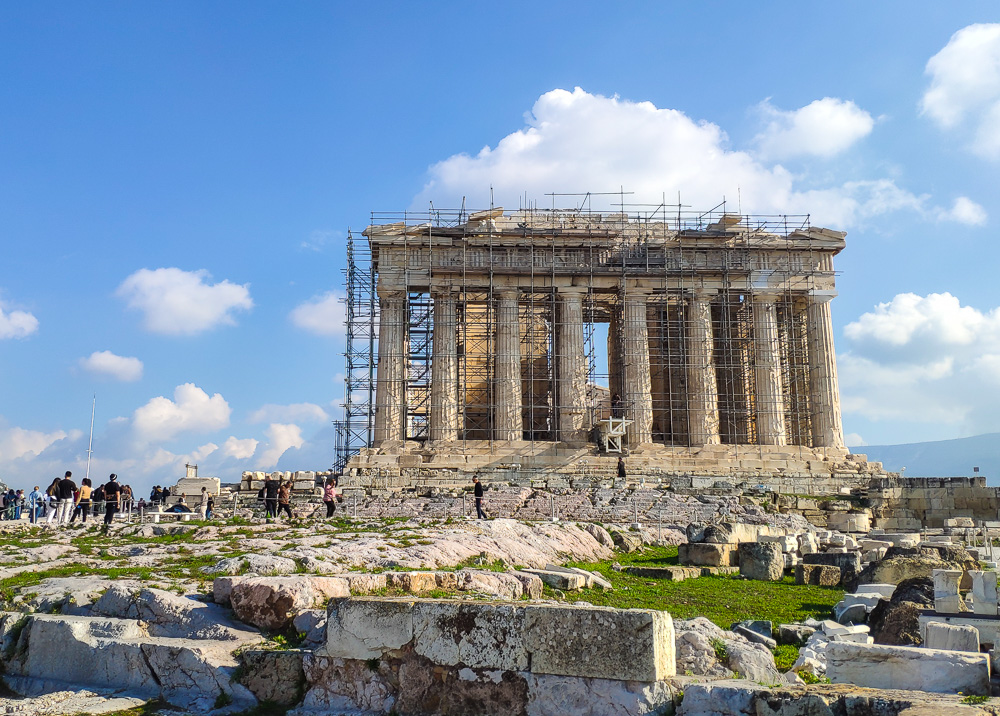
There is presently restoration work being done on the Parthenon. Much like the Propylaia, new replacement marble blocks have been inserted to restore the Parthenon to a slightly more complete state. Unfortunately the works require some heavy machinery and scaffolding, so you’re currently not going to get that perfect picture of the ancient temple.
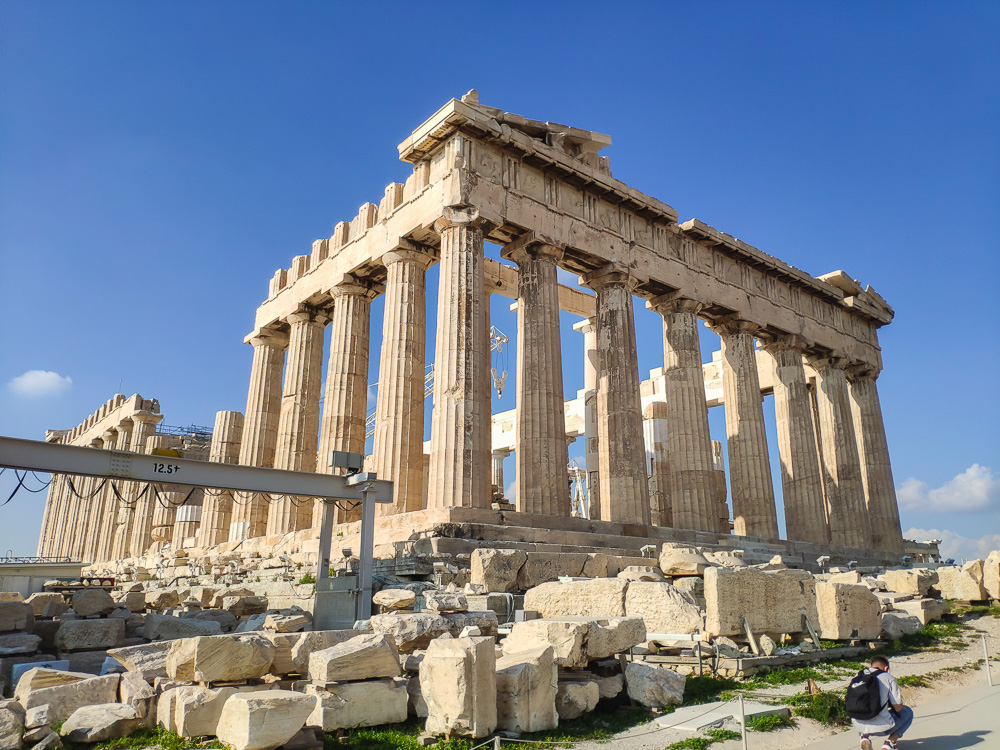
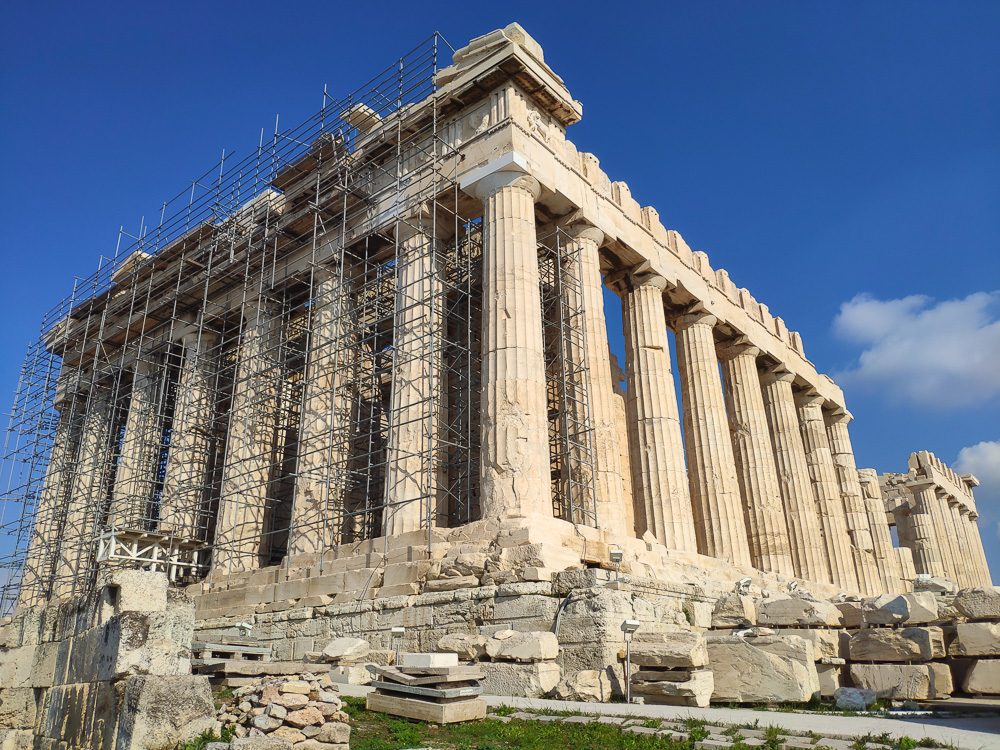
The Parthenon as it stands today has had a long and storied history. Work started on its construction around 447 BC with full completion taking place around 432 – 431 BC (some 2455 years ago). Its design was done by the architects Iktinos (Ἰκτῖνος) and Callicrates (Καλλικράτης), whereas the master sculptor Phidias (Φειδίας) was responsible for the temple’s sculptures (i.e the pediment, the metopes, and the friezes). The sculptures have mostly been removed from the temple and were placed in the nearby Acropolis Museum. This is aimed at better preservation in a climate controlled environment free from the elements, and allowing for succeeding generations to continue admiring these works of art.
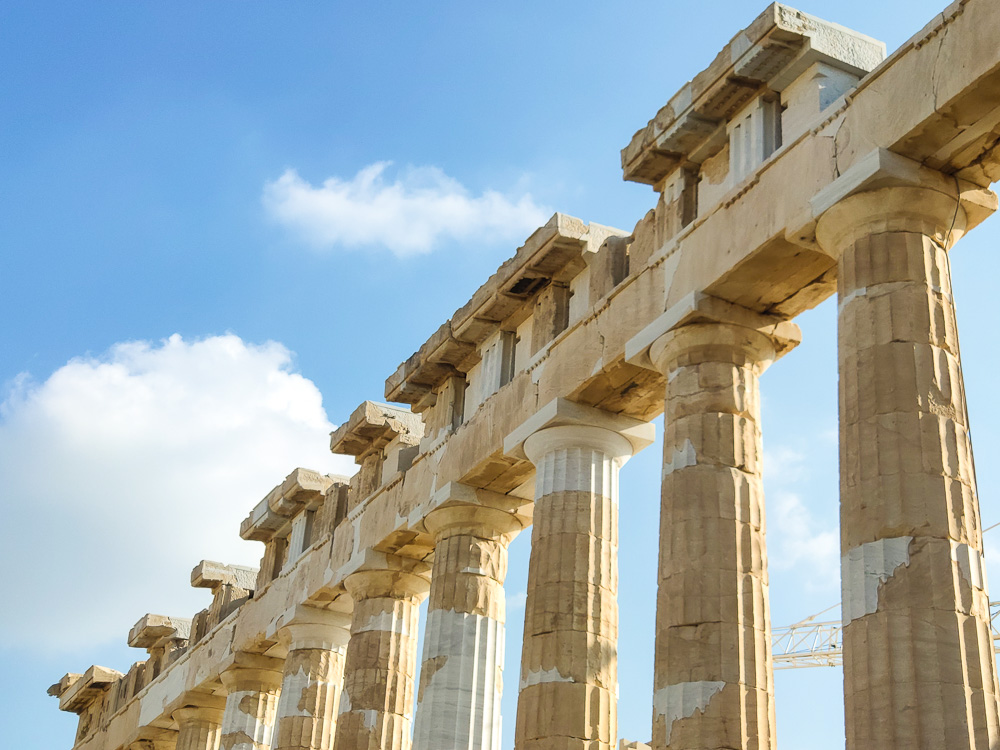
An integral feature of the Parthenon was the statue of Athena Parthenos (Παρθένος Ἀθηνᾶ), a monumental statue of the goddess Athena made of gold and ivory. The statue was placed in a chamber of the Parthenon (the “naos”), more specifically in the east side (the “hecatompedos neos”), while the western chamber housed treasures of the League of Delos and other offerings. The Athena Parthenos itself was also an offering from the city to its patron goddess, instead of being an object of devotion as might be assumed.
Unfortunately, the approximately 11.5 metre high statue was lost to history some time in the first millennium. The scale of the statue did mean that a good number of descriptions survive to this day, and once again our friend Pausanias has a thing or two to say about it:
[7] The statue of Athena is upright, with a tunic reaching to the feet, and on her breast the head of Medusa is worked in ivory. She holds a statue of Victory about four cubits high, and in the other hand a spear; at her feet lies a shield and near the spear is a serpent. This serpent would be Erichthonius. On the pedestal is the birth of Pandora in relief. Hesiod and others have sung how this Pandora was the first woman; before Pandora was born there was as yet no womankind. The only portrait statue I remember seeing here is one of the emperor Hadrian, and at the entrance one of Iphicrates,1 who accomplished many remarkable achievements.
– Pausanias, Description of Greece, 1.24.7
Not all of the Parthenon’s sculptures remain in Athens, though. Between 1801 to 1812, Thomas Bruce, the 7th Earl of Elgin, unilaterally removed/plundered half of the then surviving sculptures on the Parthenon together with a number from the Erechteion, the Temple of Athena Nike, and the Propylaia. This act courted controversy almost immediately for obvious reasons and continues to this day. The return of the pieces to Greece has been consistently sought by the Greek Government since Greek independence while the UK predictably refuses to. If you want to complete your visit to the Acropolis, you’ll have to make a visit to the British Museum in London to see the pieces that Lord Elgin took.
What came before the Parthenon?
The Parthenon is not the only temple to Athena that have stood on the Acropolis. Archaeological research and a reading of ancient Greek literary works have pointed and/or revealed the existence of at least two previous temples to Athena. The first is known today as the Old Temple of Athena or the “Archaios Neos” (Ἀρχαῖος Νεώς), and is thought to have been built in the second half of the 6th-century BC in the spot between the Erechteion and the Parthenon of today. This grand old temple was then to have been replaced by a proper sanctuary to Athena, which resulted in a building effort on the site of today’s Parthenon shortly after the Battle of Marathon in 490 BC. If you’re wondering if this ‘Pre-Parthenon” was built on a clean site then the answer is No – a temple known as the “Hekatompedon” or “Hekatompedos” (ἑκατόμπεδος) stood on the site since around 550 BC.
This “Pre-Parthenon” was never completed and was then destroyed in the Achaemenid Empire’s sack of Athens during the Second Persian Invasion of Greece. Yes, that was the conflict where King Leonidas (Λεωνίδας) I of Sparta famously blocked the Persian advance at Thermopylae (Θερμοπύλαι) for three days.
The remnants of these temples are still visible today. Various sculptures from the Hekatompedon and the Pre-Parthenon were part of the collection of ruins buried on the Acropolis after the aforementioned sack by the Persians, and marble blocks from the Pre-Parthenon were incorporated into the foundations of the new Parthenon and the walls of the Acropolis. On the other hand, the foundations of the Archaios Neos is still visible today right next to the Parthenon.
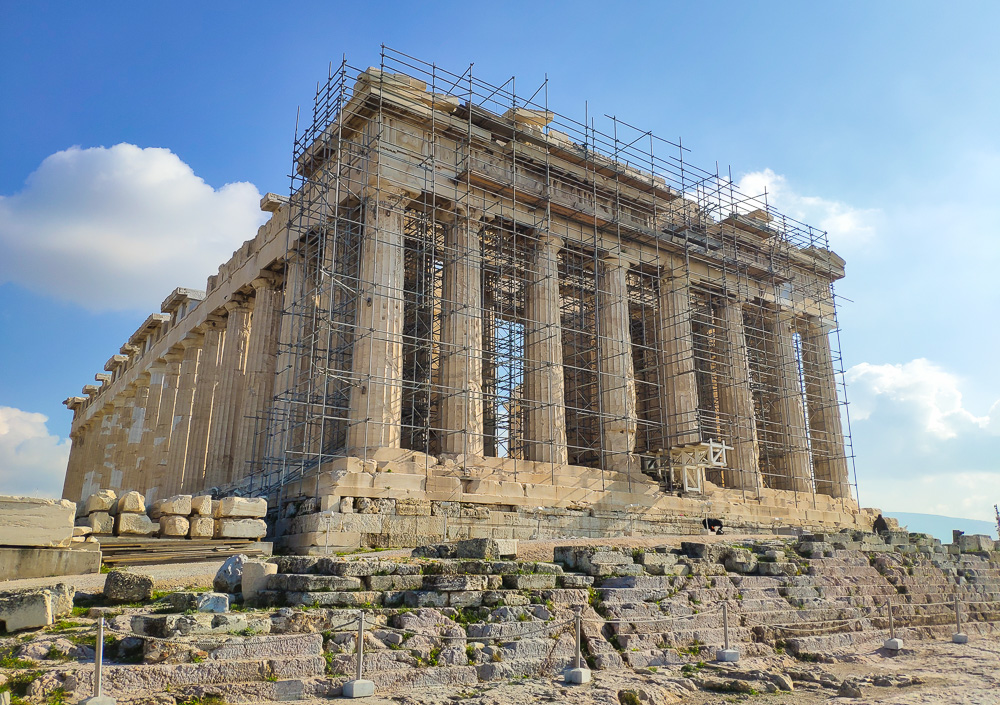
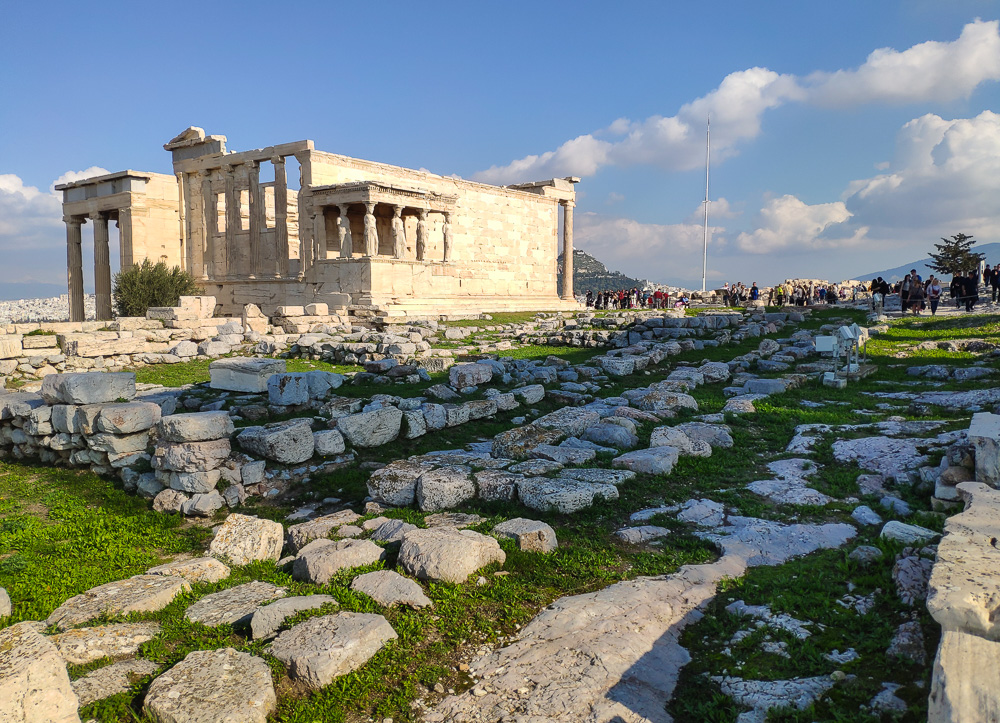
To see the surviving sculptures from the Hekatompedon, the Archaios Neos, and the Pre-Parthenon, make your way to the Acropolis Museum nearby. It’s a worthy accompaniment to any visit to the Acropolis.

The Pandroseion (Πανδρόσειον) and Athena’s Olive Tree
Located in the space between the Erechteion and the Archaios Neos was the Pandroseion, the sanctuary dedicated to Pandrosus. Pandrosus is held by the mythology to be one of the daughters of the mythical King Kekropus, the first King of Athens.
Not much remains of the Pandroseion, but the highlight of the site today is a Moria – a religiously significant olive tree. The story goes that both Athena and Poseidon competed for the patronage of ancient Athens by attempting to devise the most useful gift to the Athenians. Poseidon conjured a spring of salt water, while Athena planted what became Greece’s first olive tree. For very obvious reasons, the Athenians judged Athena’s olive tree as the more useful gift, and so became the reason why Athens isn’t named after Poseidon instead.
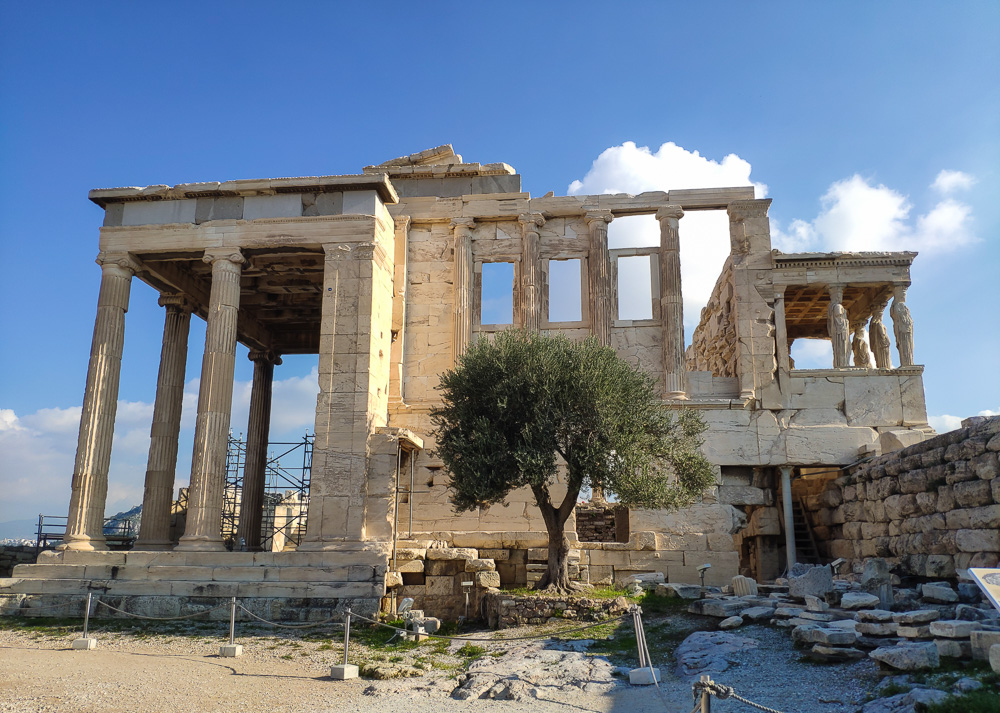
Since then, an olive tree has always grown on the Acropolis. The Moria that we see today was planted from the branch of an earlier tree that was damaged during the Nazi occupation of Greece in World War II. Tradition holds that each successive tree is a replant of the previous one through generations, so if you subscribed to the myth this tree is technically a descendant of the original Athena-given tree.
The Beulé Gate
Once you’ve had your fill of the Acropolis, simply turn around and head out of the site through the Propylaia. If you made your way up via the Southern Slopes, now is a good time to head down through the Beulé Gate. The pathway through this portal is aligned with the Propylaia and gives visitors a quick and easy way out of (or into) the site.
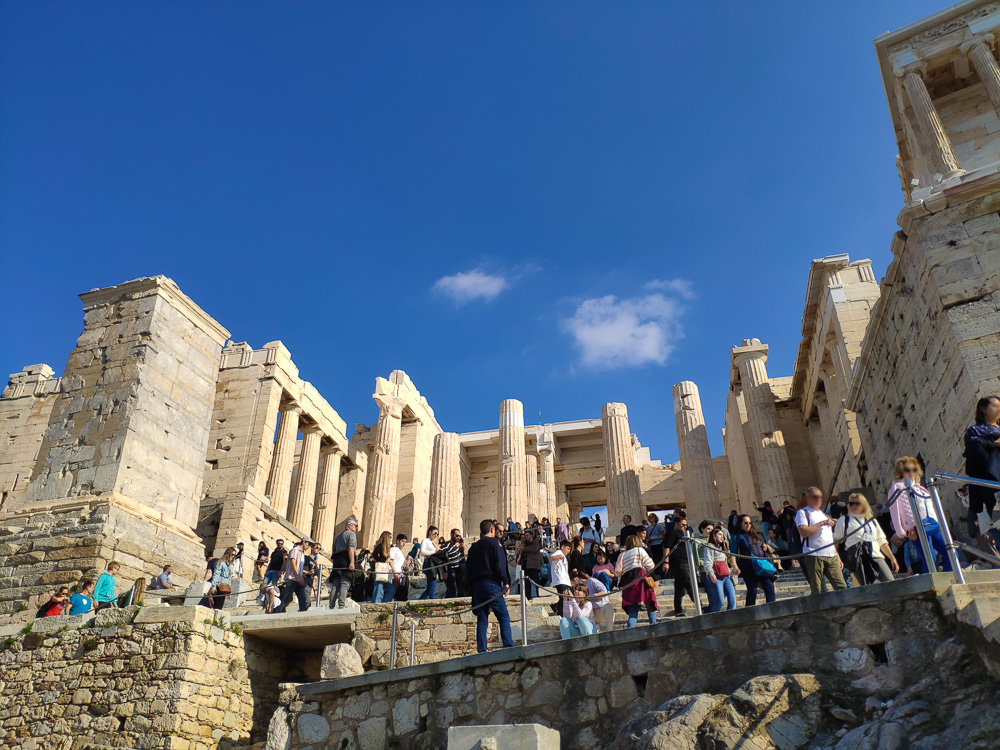
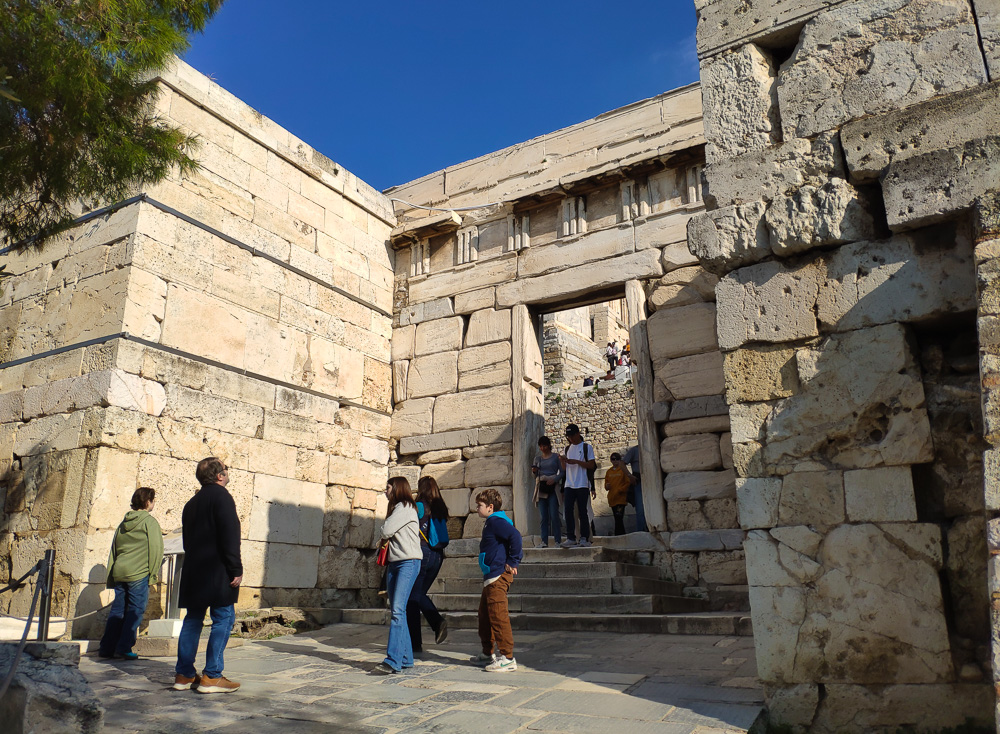
It might seem unassuming, but the Beulé Gate dates from the 3rd – 4th century AD, making it over 1700 years old and counting. The Gate was constructed from re-used material of the older Choragic Monument of Nikias, and used to be part of what is known as the “Post-Herulian Wall” (i.e the Wall built after the Heruli sack of Athens in 267 AD). The construction of this wall and the Gate is now seen as the beginning of a new era for the Acropolis, as it now served a combined Defensive – Religious purposes, while in earlier times it was a purely religious site.
The Acropolis would subsequently play a prominent role in the defensive infrastructure of Athens throughout the city’s many conflicts all the way up until the Greek War of Independence from 1821 to 1829.
The exit through the western ticket barriers are a short walk down after the Beulé Gate, and that ends the visit of the Acropolis of Athens. If you’re still aching for a view of the hilltop citadel, just make your way further down the path to the Areopagus Hill. There is no entrance fee for the Areopagus Hill, and you get a great angle of the entire outcrop.
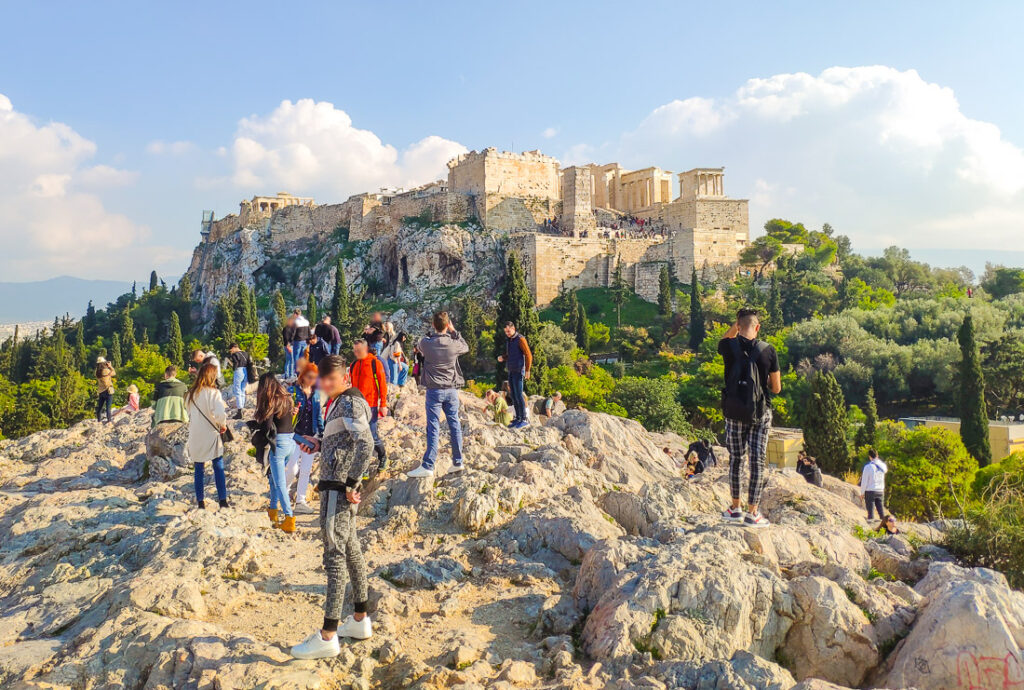
Visitor Information
Buying tickets to the Acropolis
Tickets for the Acropolis can be purchased on-site at both entry gates. As the Acropolis is hugely popular, there will always be a queue for tickets in both the Winter and the Summer. If you don’t like queueing, I recommend you start queuing first thing in the morning.
Location
The Acropolis is a 15 minute walk from Syntagma Square. It is highly distinctive and cannot be missed.
To get here from Syntagma Square, walk down Vasilissis Sofias Avenue (Λεωφόρος Βασιλίσσης Σοφίας) until just after the imposing Hadrian’s Arch on your left (on the other side of the road), and turn right on Dionysiou Areopagitou Street (Οδός Διονυσίου Αρεοπαγίτου). Walk straight down Dionysiou Areopagitou and you will then reach the South Slopes of the Acropolis of Athens; Walk further on and you’ll reach the turn to the Western Slopes.


If you’re coming by the Athens Metro, the closest station is the eponymous Akropoli (Ακρόπολη) station on Line 2 (Red). Just look for the exit on Makrygianni Street (Oδός Μακρυγιάννη). It is the closest exit to the South Slopes and the ticketing office there.
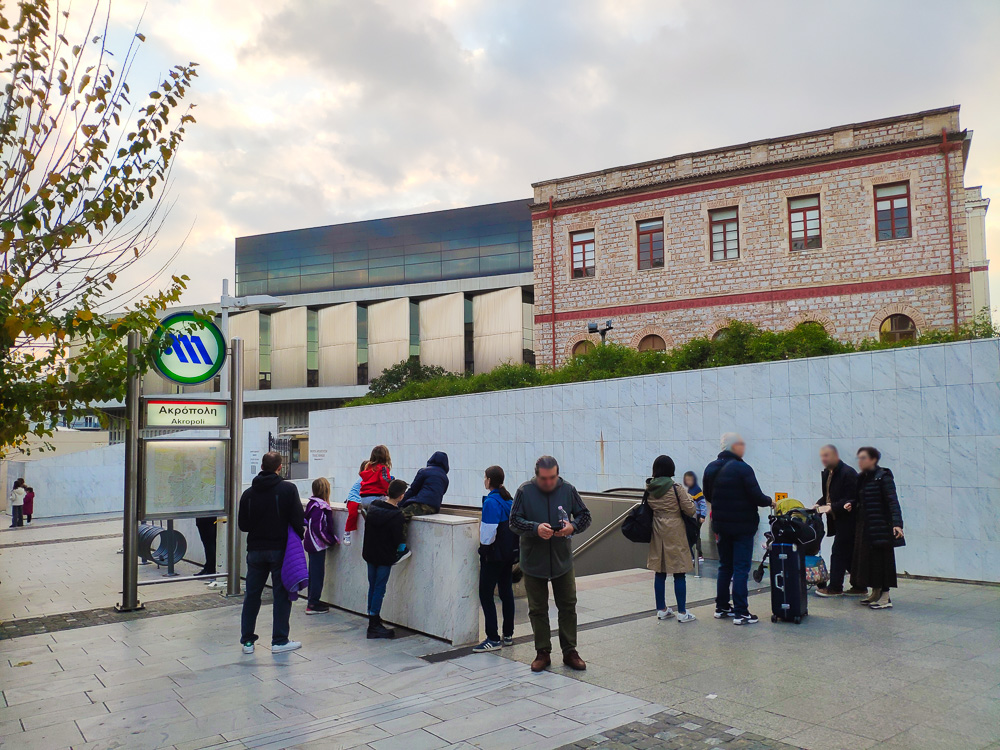
For more information including Opening Hours, check out our dedicated post on Acropolis tickets and access for the mobility impaired.
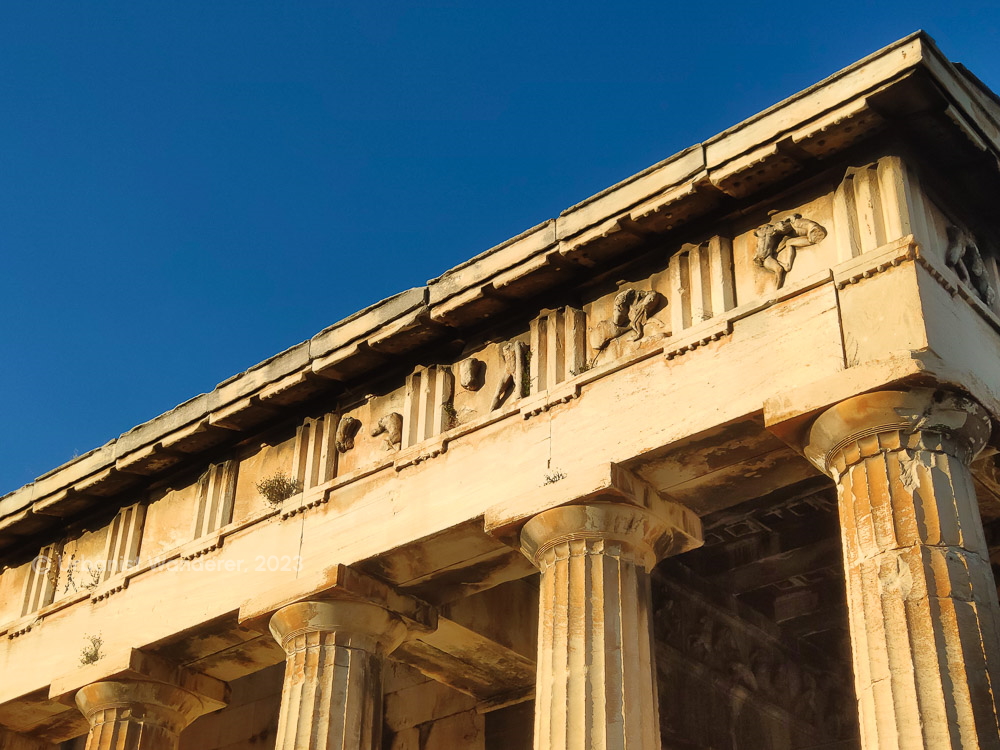
Leave a Reply